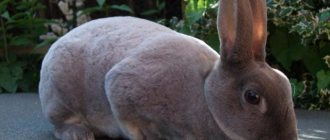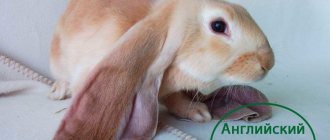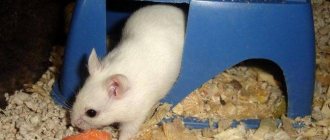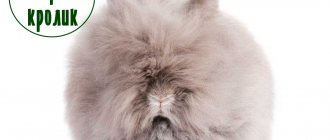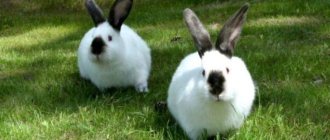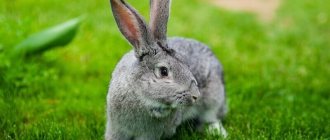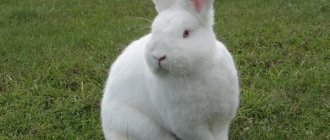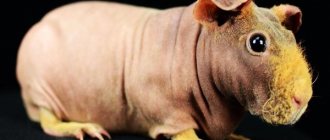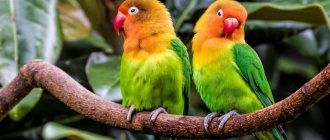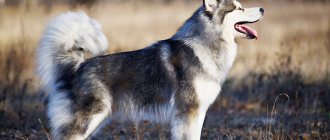Giant rabbits earned their nickname due to their impressive dimensions - the size and body weight of adult rabbits significantly exceed standard indicators, which directly affects their productivity. The advantages of giants also include high fertility and good vitality.
Breeding giants is more profitable, since they are almost 2 times larger in weight and size than their ordinary relatives
From our article you will learn how to properly care for representatives of large breeds of rabbits.
Table of average weight of different breeds by month
To quickly determine the weight of a rabbit, scheduled by month, without going into detail, many breeders use special tables. You can find them online in all sorts of variations, taking into account different breeds.
As an example, one such table is presented below:
This list shows only average values, suggesting certain deviations up or down. But these numbers give the breeder a guideline with which to refer in the process of raising animals.
Belgian Flanders
This giant also takes pride of place among the huge species of rabbits. Considered the most common and ancient breed
In the USSR, the Belgian rabbit received close attention among breeders due to its high fertility. The very first mention of this breed dates back to the 17th century.
There is still controversy over the origin of the Benguela rabbit. Some believe that he was brought from Argentina, others believe that this giant appeared by crossing Argentine Patagonian individuals with large Flemish rabbits.
Naturally, they cannot be called cute, because their body length is massive and is more than 70 cm in length. Reaches its normal weight of 12 kg within 1.5 years. At the moment, there are many branches of this breed: English, White, Spanish Flanders.
The skin of white giants is very valuable in the fur market
Standard indicators
If we talk about average indicators, then the weight of a rabbit should be from 4 to 5 kg, however, in practice, there are cases when record holders with a weight of 8 kg grew up on farms in those breeds that are not characterized by such an indicator. The weight of a two-week-old regular rabbit is no more than 45 grams, but it may be less, depending on the breed.
You need to understand that live weight and slaughter weight are not the same thing and the difference between them is 30%, which includes the skin and internal organs. With a live weight of a rabbit of 5 kilograms, the slaughter yield is only 1.5 kg. If a live rabbit weighs 10 kg, then the carcass is only 7 kg.
Newborn rabbits weigh very little, they are hairless and blind.
A newborn rabbit weighs only 62 grams; by 1 month it increases to 800 grams. At 3 months his weight is 2700 g, at 4 months 3.6 kg and at 6 months 5.5 kg. The weight gain is 50-60 grams per day.
Month-old offspring feed exclusively on mother's milk; as a result of such a balanced menu, their weight increases 10 times. Despite the fact that the weight no longer increases at this rate, it still continues to grow, and by 5 months the rabbit has gained 70% of its maximum weight. On average, a healthy animal should weigh 3.5 kg by the specified date.
It is worth saying that only large breeds, which are distinguished by record performance, are grown for commercial purposes. They differ from other breeds in that they grow quickly and after only 9 months they are ready for slaughter. An adult rabbit reaches its maximum weight at 10 months.
Weight of Flanders rabbits by month
The largest breed has, accordingly, the largest body weight at any age.
Flandres are very popular among breeders. All worries and costs become justified when selling large quantities of meat products. High-quality care will ensure the weight of rabbits of this breed is about 10 kg. Record holders with a mass of 25 kg have been recorded.
Flanders is also famous for the rapid increase in body weight in young animals. The initial start is no different from other types. But, if the weight of a newborn is about 60 g, then by a month this value will reach 800 or more grams. The peak occurs at the age of 9 months, when it is advisable to slaughter. The excellent growth dynamics are impressive and make Flanders breeding an attractive business.
Weight of white giant rabbits
The descendant of Flanders is the White Giant.
Its adaptability to cold climates allows it to be bred in Russia. One litter brings offspring of up to 14 newborns. After a month, the average weight of a rabbit of this breed is about 750 grams, which is slightly inferior to Flandres. He continues to lag behind him further. At 8 months the average is about 5.7 kg. Of course, a balanced diet with supplements will lead to an increase in this figure, but still you should not try to keep up with the record holder. The white giant brings sufficient profit for obtaining a large amount of dietary tasty meat.
Soviet chinchilla
Soviet chinchillas were obtained by crossing white giants with chinchilla rabbits. The resulting breed is classified as meat and wool.
Representatives of the breed line are distinguished by strong bones and muscular physique. In addition, their wool, which is thick, silky and blue-gray in color, is highly prized.
A chinchilla weighs about 4-6 kg. At the same time, weight gain in young animals occurs at the following pace:
- newborn rabbit 75 g;
- 2 month 1.8 kg;
- 3 month 2.7 kg;
- 4 month 3.6 kg.
The main advantages of the variety are high meat yield, unpretentiousness to living conditions, and greater resistance to cold.
Butterfly and ram
Rabbit butterfly
Butterflies are decorative rabbits with a strong skeletal system. They have a well-built, muscular body and equally strong legs, a wide chest and a long back. The head shape is round.
The coat of representatives of this breed is predominantly white, and the sides, nose, ears, tail and paws are covered with black spots. There is also a spot on the face that is shaped like a butterfly. An adult weighs between 4-5 kg.
French ram.
The ram is distinguished by its hanging ears. In addition, it has prominent frontal bones on its muzzle and plump cheeks. The body of individuals of this breed is slightly elongated, the chest is deep, the back is wide, the legs are strong and muscular.
Rams have thick and fluffy agouti-colored fur. The color can be different: black, white, grayish, motley, etc. At adulthood, rabbits weigh 4.5 kg.
Californian
Among the large breeds of rabbits is the Californian. It was bred from the New Zealand and Himalayan breed lines, and the official homeland of the breed is the state of California in the USA.
Breeders keep such rabbits both for tasty dietary meat and for valuable fur. The animal shows fairly high productivity in both areas. Moreover, the average weight of a California breed rabbit is 44.7 kg. Significantly less common are individuals whose mass exceeds this figure.
California rabbit weight
As for the growth rate of young animals, it assumes the following weight values by month:
- immediately after birth 50 g;
- after 2 months 1.71.9 kg;
- after 3 months 2.7 kg;
- after 5 months 3.5 kg;
- after 6 months 4-4.1 kg.
Representatives of the breed gain maximum weight by 7-8 months of life.
Risen
The Risen breed, or German giant, has gained great popularity due to the gigantic size and slender physique of its representatives. The most pronounced features of the appearance of such living creatures include the following:
- long body;
- strong wide chest;
- thick, knitted paws;
- long erect ears;
- short but thick coat of black, white, gray or blue color.
An adult rabbit of this variety weighs from 6.5 to 10 kg, and its massiveness affects the way the animals move. They are extremely clumsy when moving.
Hiplus
These animals are distinguished by a long body and short legs. The head and neck are small, the ears are small, and the coat is thick. Representatives of the breed do not have a characteristic color feature; there are spotted individuals, black or gray. Eyes may also vary in color.
Rabbits have become popular among breeders due to their high weight, rapid growth and good weight gain with a small amount of feed. A rabbit can gain from 55 g per day, and if it is kept on intensive fattening, then by the age of 3 months the animal will gain 5 kg.
It is worth saying that the rapid growth is accompanied by high resistance of the breed to intestinal diseases, which is why breeders receive the maximum profit from this breed.
Despite the large number of advantages, the breed also has its disadvantages: it is necessary to constantly update the livestock and acquire new rabbits.
Silver
The breed originates in Champagne. They are famous for their unusual fur color, which classifies the animals as meat-hide breeds. After entering the territory of our country, domestic breeders continued to improve the breed.
The average weight of adult animals is 4.5-5 kg, and representatives with greater weight can be found.
New Zealand
New Zealand rabbits, despite their name, also originate from California. When breeding them, breeders used several breeds, among which the main ones were the Flemish rabbit and the Belgian hare.
Subsequently, the breeders continued to work on the breed line, adding to it the blood of the Angora, American white rabbit and some other breeds.
As a result, the breed line was divided into 2 subtypes:
- Reds. They got their name because of their red-brown fur and brown eyes.
- White. White New Zealand rabbits are distinguished by completely white down and red eyes.
In addition to pronounced exterior features, the subtypes differ among themselves and in weight. Thus, red representatives of the breed weigh on average up to 5 kg, while adult white ones reach only 4-4.7 kg.
Their monthly growth suggests the following values:
- newborn 60 g;
- 1 month 600 g;
- 3 month 2.5 kg;
- 5 month 3.5 kg;
- 7 month 4.1 kg.
A characteristic feature of this breed is also that the female rabbit always weighs more than a male of the same age.
Features of maintenance and care
It is more advisable to place rabbits of giant breeds in wooden cages, placing them in places protected from direct sunlight and drafts. The home should be spacious. Its dimensions are determined individually, taking into account the age and breed of the animal. To raise an adult giant, a cage with an area of at least 0.6 m2 (80×100×65 cm) is required; for a female rabbit with cubs, you will need an enclosure measuring at least 100×150×65 cm.
The cage must be spacious, clean, protected from adverse weather conditions
When preparing a home for rabbits, it is more practical to make the floor from a metal mesh, since it is practically not contaminated with feces, which ensures cleanliness and simplifies maintenance. But representatives of some giants, for example, white and gray, due to their large weight, have a predisposition to the appearance of corns and the occurrence of pododermatitis. Therefore, the flooring for each breed of rabbit is selected individually. The solid bottom should be covered with hay, straw or sawdust. The last option is the most preferable, since sawdust perfectly absorbs moisture and eliminates unpleasant odors.
There must be space in the cage for a feeder and drinking bowl, and a queen cell should be equipped for the female.
The mother liquor is necessary for breeding and milk feeding of baby rabbits up to an average of 1.5 months of age.
Representatives of breeds that are adapted to Russian climatic conditions and tolerate cold temperatures well can be kept outdoors all year round. However, in severe frost, it is better to bring the cages indoors, as there is a risk of frostbite to the extremities.
It is important to keep areas where animals are kept clean to prevent the spread of viruses and bacteria. Cleaning is required at least 1-2 times a week.
The following video will introduce you to an interesting way of equipping a cage for a large rabbit:
Record holders among long-eared animals
Ralph Rabbit's story is like a roller coaster. Paulina Grand's ward is considered the largest. But doctors are seriously concerned about the pet’s well-being. Today, the weight of the big-eared celebrity is 22 kg, although the owner assures that she provides the rabbit with physical exercise. However, the giant is outwardly active and does not show any dissatisfaction with its maintenance or care. The body length of the playful domestic hare is 130 cm.
Darius is another former Belgian breed record holder. In 2010, he even managed to dislodge Ralph, however, after that he lost ground with a weight of 19 kg. His owner, Annette Edwards, had previously registered large rabbits in the Book of Records; they were the parents of Darius. Apparently, the hereditary factor played a huge role in this particular case. The length of the body in 2010 was inferior to the current leader. True, according to some reports, the pet will soon snatch the palm from Ralph again. The owner claims that the rabbit gained weight 22.2 kg and grew to 130 cm.
Jeff is the son of Darius, so it is not surprising that the whole world expects big victories from him. Annette, as a specialist in breeding ornamental breeds, is confident that Jeff will become a record holder. Now the rabbit is 3 years old, but its body length is already 95 cm. Miss Edwards is happy to tell the secret of such success in an interview. First of all, this is a balanced diet, as well as physical exercise. For example, Darius’s weight, as Annette admits, is largely determined by muscles. He is very active, runs constantly, and his caring owner spends the lion's share of her financial resources on quality maintenance. The price of good food for large breeds is high, which forces the farmer to turn to relatives for help.
Top 16 interesting facts about rabbits
- All but one species of rabbit lives in underground burrows. This distinguishes them from hares, which build nests on the surface.
- The length of rabbit ears can exceed ten centimeters, and the world record is almost eighty centimeters.
- When they detect danger, such as a predator, rabbits warn their relatives by drumming their front paws on the ground or on a tree.
- Rabbits easily jump to a height of a meter and a half.
- In nature, rabbits live on average about a year, and in captivity - ten times longer. This is due to the fact that almost all rabbits sooner or later become someone’s prey.
- The officially registered record for rabbit longevity was 19 years.
- A female rabbit can carry two offspring at the same time, conceived at different times and from two different males, since she has a bifurcated uterus. This partly explains the fertility of these creatures.
- The only part of a rabbit's body that sweats is the pads of its feet.
- If you scare a rabbit too much, it can actually die from fear.
- When running, a rabbit can reach speeds of up to 55 km/h, which is inferior to that of hares - up to 70 km/h.
- A rabbit driven into a corner resorts to its last weapon - a powerful strike with its hind legs, armed with strong claws.
- Brought to Australia, rabbits proliferated on the territory of this continent to such an extent that they began to pose a threat to the entire Australian ecosystem. To contain their spread, the government of this country even had to erect a special fence around areas teeming with rabbits.
- When eating food, the rabbit makes two chewing movements every second, that is, about one hundred and twenty per minute.
- In some Australian states, keeping rabbits as pets is prohibited, and violators face a huge fine.
- Rabbits can jump up to three meters.
- Rabbits' eyes are designed in a very unusual way - these creatures can see what is happening behind them without even turning their heads.
https://7ogorod.ru/kroliki/samyj-bolsoj-v-mire.html
https://stofactov.rf/16-interesting-facts-about-rabbits/
What to feed rabbits to gain weight quickly?
Breed is one of the main criteria that determines the weight of an animal, but achieving the average values prescribed by the breed is possible only if proper feeding is implemented. And in this regard, diversity is the principle.
In addition to green grass, a rabbit's diet must include:
- grain feed;
- compound feed;
- cake;
- young branches of deciduous trees;
- vegetables;
- beans;
- mineral supplements in the form of chalk and bone meal.
Young animals are fed at least 4 times a day, reducing the frequency of feedings to two as they grow older.
The weight of a rabbit largely depends on the breed to which it belongs. Depending on the variety, the weight of such animals ranges from 3 to 10 kg.
Breeding methods
With good maintenance and proper feeding, giants quickly gain weight and regularly give birth to offspring. When born, babies weigh on average 80–85 grams. With a good diet, by the age of one and a half months they already weigh 1.5 kg, develop quickly and produce high-quality meat.
There are two main ways to fatten giant rabbits.
- Independent preparation of a diet from hay, vegetables, grain crops, succulent feed.
- Using special feed for giants.
The second method has a number of advantages, since compound feed provides balanced nutrition, which is difficult to achieve when preparing a diet yourself. The feed contains the required amount of vitamins, micro- and macroelements. Moreover, there are special feeds intended for feeding young animals, for fattening animals for meat, pregnant and lactating females, and male producers.
When using compound feed, it is necessary to give your pets additional hay.
Nutritional supplements for artificial weight gain
To improve appetite, breeders add vitamins to pet food. Beneficial substances of groups A and E are used together with fats, vitamin D is added to thick and porridge-like food. The drink is diluted with vitamin C.
After consultation with a veterinarian, animals are prescribed vitamin-mineral, as well as protein-vitamin-mineral supplements (PVMD).
They strengthen the animals’ bodies with useful microelements: manganese, calcium, phosphorus. Protein-containing options provide protein to the animal's muscles.
Vitamin and protein supplements have no contraindications. The correct dosage is calculated taking into account the body weight and age of the pet. The use of additives above the norm worsens the taste characteristics of rabbit meat.
In Russia
In the Russian Federation, the Soviet Chinchilla is considered a large breed. On average, its representatives are not much larger than ordinary rabbits, but they can be raised to a very large size, several times larger than normal. These rabbits have beautiful fur with a hint of blue. Adults can reach a body weight of 6 kilos. But pets require large cages or enclosures to keep them.
The young are noticeable by their rapid growth, weight gain and unpretentiousness to food. Domestic rodents are quite adaptive in new living conditions. And most importantly, any climate suits them.
To breed a purebred large Gray rabbit, a large Flandre rabbit was used for selection, from which the color characteristics of the skin, large size and weight were genetically transmitted to the new species. The average body weight of a rabbit reaches 7 kilograms, and it can grow up to 66 centimeters long. The gray pet has high vitality and strong immunity.
When the White Flanders and the Gray Giant were crossed, then the Soviet Chinchilla, this led to the emergence of a new breed of the White Giant rabbit. A very large albino with reddish eyes and snow-white fur. The nature of the animals is calm. Cute and peaceful animals are loved to be bred as decorative pets. Their body weight reaches 6 kilos. The fur of rabbits is thick, a square centimeter is occupied by 20 thousand hairs, each hair is surrounded by 24 downy hairs.
A proper diet is the key to health!
I will repeat a common truth, which, however, most rabbit breeders lose sight of: rabbit food must be perfectly balanced. As experienced rabbit breeders say: If you feed only hay, the rabbit will only grow ears. Translating into a more scientific language, I will say that the speed of weight gain and the condition of the gastrointestinal tract of animals depend on the quality and calorie content of food.
Feeding only hay is an extremely low-calorie diet that will support life and healthy intestinal motility. To gain weight, animals need to be fed grain bait, whole grain or crushed grain. In addition, they are given mineral supplements and soft food. Instead of creating a menu manually, it is easier to purchase ready-made feed - a balanced mixture of grains, bone meal and minerals.
A varied diet is the key to the health and rapid growth of a rabbit.
Minerals are especially needed by breeding animals and those breeds that are raised for fur. Grain mixtures containing legumes, corn, sunflower or rapeseed are available for sale. These supplements are high in calories and promote weight gain.
There are foods that are contraindicated for animals:
- fresh grass on which pathogenic bacteria are present, because in 95% of cases, epidemics that can destroy livestock in the territory of an entire village are transmitted precisely through fresh leaves;
- some types of plants containing toxins: foxglove, lily of the valley, henbane, colchicum, lumbago, buttercup and others;
- branches of stone fruit trees and the essential oils they contain are toxic to animals;
- bread crumbs can clog the intestines, which leads to the painful death of animals within 24 hours.
Feeding
Feeding giants does not cause farmers any serious trouble. The main thing is that the animals’ diet is varied and balanced. Rabbit breeders recommend giving their pets grass, hay, vegetables (root vegetables, cabbage), fruits, special feed with a high protein content, and tree branches (not stone fruits). The animals' diet also includes grains (oats, barley) and legumes, bran and cakes, mineral and vitamin supplements. It is strictly forbidden to feed rabbits wheat, low-quality feed, spoiled food - all this can lead to illness or even death of the animal.
The diet of rabbits should be varied, rich in proteins and vitamins.
Collecting grass for rabbits should be done with extreme caution, because some plants can be dangerous to the health of animals. It is necessary to avoid buttercups, henbane, lumbago, lily of the valley, colchicum, foxglove, etc.
It is better to feed your pets in small portions on a schedule - several times during the day. This will normalize the functioning of the digestive system and improve the quality of rabbit meat. Overeating, which can lead to obesity in animals, should not be allowed.
Insufficient feeding can lead to stunted growth and development of animals, however, overeating is also dangerous for them
Effect on the growth of a rabbit's milk production
Favorable conditions for a high growth rate of animals are the high milk production of the female and her responsible attitude to the feeding process. The increased growth after such a push will continue even after the young are separated from their mother.
Rabbit milk is a high-calorie product containing all the necessary vitamins and minerals. Rabbits born in the summer will be provided with higher quality milk than with spring offspring. Milk production is somewhat reduced when birth occurs for the first time. The Californian breed and Soviet chinchillas have the best milk production indicators. Females with this indicator have a longer body and wider chest coverage.
When to slaughter
If we talk about the timing of slaughter, then it all depends on the purpose of breeding animals. To obtain tender meat products, animals go under the knife as soon as they reach the desired weight. And if the goal is to obtain meat and good skin, then you need to take into account some points. It all depends on the time of molting. In case of untimely slaughter, the resulting skin products are of poor quality, and over time the skin will simply become bald.
To choose the most optimal slaughter time, you can use the following recommendations:
- young animals born in winter are slaughtered on day 120;
- In young animals born in summer, molting ends in November;
- after vaccinations, animals are sent to slaughter only a month later;
- most breeds are slaughtered when they reach a weight of 1.6 kg;
- The best time to score is from November to March.
We invite you to join our Zen channel and group on VKontakte or Odnoklassniki, where new articles are published, as well as news for gardeners and livestock breeders.
Similar articles:
- Breed overview: Russian ermine rabbit
- Coniferous branches in the winter diet of rabbits
- Should you give zucchini to rabbits?
Continental Giant – champion breed
Compared to the giants described above, this rabbit is truly a giant. This is the oldest domesticated breed of rabbits, which became known in the 16th century. The body weight of “Conti” reaches 16 kg or more and the fur color is very diverse. Most people keep this breed at home, not for the purpose of breeding and eating, but as a regular pet. They have a gentle disposition and gladly allow themselves to be petted. The body length of the Continental Giant reaches 70 cm or more, and females are much larger.
“Conti” often participates in various exhibitions, always receiving prizes. Today it is a kind of tradition to take such a rabbit to a competition.
